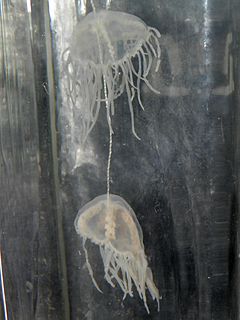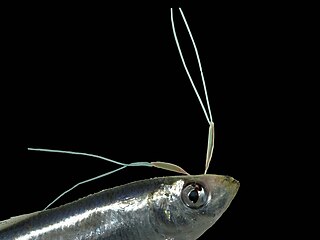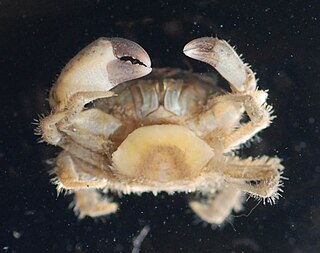
Parasitism is a close relationship between species, where one organism, the parasite, lives on or inside another organism, the host, causing it some harm, and is adapted structurally to this way of life. The entomologist E. O. Wilson has characterised parasites as "predators that eat prey in units of less than one". Parasites include single-celled protozoans such as the agents of malaria, sleeping sickness, and amoebic dysentery; animals such as hookworms, lice, mosquitoes, and vampire bats; fungi such as honey fungus and the agents of ringworm; and plants such as mistletoe, dodder, and the broomrapes. There are six major parasitic strategies of exploitation of animal hosts, namely parasitic castration, directly transmitted parasitism, trophically transmitted parasitism, vector-transmitted parasitism, parasitoidism, and micropredation.

Copepods are a group of small crustaceans found in nearly every freshwater and saltwater habitat. Some species are planktonic, some are benthic, a number of species have parasitic phases, and some continental species may live in limnoterrestrial habitats and other wet terrestrial places, such as swamps, under leaf fall in wet forests, bogs, springs, ephemeral ponds, and puddles, damp moss, or water-filled recesses (phytotelmata) of plants such as bromeliads and pitcher plants. Many live underground in marine and freshwater caves, sinkholes, or stream beds. Copepods are sometimes used as biodiversity indicators.

In biology and medicine, a host is a larger organism that harbours a smaller organism; whether a parasitic, a mutualistic, or a commensalist guest (symbiont). The guest is typically provided with nourishment and shelter. Examples include animals playing host to parasitic worms, cells harbouring pathogenic (disease-causing) viruses, a bean plant hosting mutualistic (helpful) nitrogen-fixing bacteria. More specifically in botany, a host plant supplies food resources to micropredators, which have an evolutionarily stable relationship with their hosts similar to ectoparasitism. The host range is the collection of hosts that an organism can use as a partner.

Hydrozoa are a taxonomic class of individually very small, predatory animals, some solitary and some colonial, most living in salt water. The colonies of the colonial species can be large, and in some cases the specialized individual animals cannot survive outside the colony. A few genera within this class live in fresh water. Hydrozoans are related to jellyfish and corals and belong to the phylum Cnidaria.

A hyperparasite is a parasite whose host, often an insect, is also a parasite, often specifically a parasitoid. Hyperparasites are found mainly among the wasp-waisted Apocrita within the Hymenoptera, and in two other insect orders, the Diptera and Coleoptera (beetles). Seventeen families in Hymenoptera and a few species of Diptera and Coleoptera are hyperparasitic. Hyperparasitism developed from primary parasitism, which evolved in the Jurassic period in the Hymenoptera. Hyperparasitism intrigues entomologists because of its multidisciplinary relationship to evolution, ecology, behavior, biological control, taxonomy, and mathematical models.

Gonionemus is a genus of hydrozoans that uses adhesive discs near the middle of each tentacle to attach to eelgrass, sea lettuce, or various types of algae instead of swimming. They are small and hard to see when hanging onto swaying seaweed. Nevertheless, they are capable of swimming when necessary. The bell is transparent, revealing the four orange to yellowish-tan gonads that lie along most of the length of the four radial canals. The pale yellow manubrium has four short, frilly lips. Up to 80 tentacles line the bell margin, with about an equal number of statocysts. Copepods are a favored prey.
Syndinium is a cosmopolitan genus of parasitic dinoflagellates that infest and kill marine planktonic species of copepods and radiolarians. Syndinium belongs to order Syndiniales, a candidate for the currently uncultured group I and II marine alveolates. The lifecycle of Syndinium is currently not well understood beyond the parasitic and zoospore stages.

Pennellidae is a family of parasitic copepods. When anchored on a host, they have a portion of the body on the outside of the host, whereas the remaining anterior part of the parasite is hidden inside tissues of the host.

Lernaeocera branchialis, sometimes called cod worm, is a parasite of marine fish, found mainly in the North Atlantic. It is a marine copepod which starts life as a small pelagic crustacean larva. It is among the largest of copepods, ranging in size from 2 to 3 millimetres when it matures as a copepodid larva to more than 40 mm as a sessile adult.

Peachia quinquecapitata, also known as the twelve-tentacled parasitic anemone, is a species of sea anemone in the family Haloclavidae. It is found in the Pacific Northwest. The larva is parasitic on certain species of Anthomedusae.

Limnomedusae is an order of hydrozoans.
Pennella is a genus of large copepods which are common parasites of large pelagic fishes. They begin their life cycle as a series of free-swimming planktonic larvae. The females metamorphose into a parasitic stage when they attach to a host and enter into its skin. The males are free swimming. Due to their large size and mesoparasitic life history there have been a number of studies of Pennella, the members of which are among the largest of the parasitic Copepoda. All species are found as adults buried into the flesh of marine bony fish, except for a single species, Pennella balaenopterae which can be found in the muscles and blubber of cetaceans and occasionally other marine mammals, and is the largest species of copepod.
Ellobiopsis is a genus of unicellular, ectoparasitic eukaryotes causing disease in Gómez F, López-García P, Nowaczyk A, Moreira D (2009). "The crustacean parasites Ellobiopsis Caullery, 1910 and Thalassomyces Niezabitowski, 1913 form a monophyletic divergent clade within the Alveolata". Syst. Parasitol. 74 (1): 65–74. doi:10.1007/s11230-009-9199-1. PMID 19633933.. This genus is widespread and has been found infecting copepods from both marine and freshwater ecosystems. | classis = [[ parasitism has been seen to interfere with fertility in both sexes of copepods.
Maeotias is a genus of hydrozoans in the family Olindiidae. It is a monotypic genus with only a single species, Maeotias marginata, commonly known as the Black Sea jellyfish or brackish water hydromedusa and often referred to as Maeotias inexpectata in the literature. It was first described from the Don and Kuban estuaries of the Sea of Azov, and also occurs in the Black Sea, all of which are areas of low salinity. It has been recorded in several other estuarine locations around the world and is regarded as an invasive species.
Peniculisa is a genus of marine parasitic copepods in the family Pennellidae.

Hydrichthys sarcotretis is a species of colonial marine hydrozoans now included in the family Pandeidae. The polyps of members of this genus are parasitic and attach themselves to a fish. H. sarcotretis is a species that exhibits hyperparasitism by attaching itself to a copepod, itself the parasite of a fish.
Cardiodectes bellottii is a species of copepods in the family Pennellidae. It is a parasite of fish. It is found in the Atlantic and Pacific Oceans as well as the Mediterranean Sea; specimens from the Pacific were formerly treated as a separate species, Cardiodectes medusaeus.

Loxothylacus panopaei is a species of barnacle in the family Sacculinidae. It is native to the Gulf of Mexico and Caribbean Sea. It is a parasitic castrator of small mud crabs in the family Panopeidae, mostly in the Gulf of Mexico, the Caribbean Sea and the eastern Atlantic Ocean.

Lernaeenicus sprattae is a species of copepod in the family Pennellidae. It is a parasite of the European sprat and certain other fish and is sometimes known as the sprat eye-maggot.

Peniculus hokutoae is a species of parasitic pennellid copepod. It was described in 2018 from a single female. The type-host is the myctophid fish Symbolophorus evermanni and the type-locality is off Japan. The Japanese name of this species is hokuto-kozutsu-hijikimushi.














